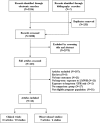Effects of Long-Term Low-Molecular-Weight Heparin on Fractures and Bone Density in Non-Pregnant Adults: A Systematic Review With Meta-Analysis
- PMID: 26895998
- PMCID: PMC4945546
- DOI: 10.1007/s11606-016-3603-8
Effects of Long-Term Low-Molecular-Weight Heparin on Fractures and Bone Density in Non-Pregnant Adults: A Systematic Review With Meta-Analysis
Abstract
Background: Adults who require long-term anticoagulation with low-molecular-weight heparin (LMWH) such as cancer patients or the elderly may be at increased risk of fractures.
Objective: To determine the effects of LMWH therapy of at least 3 months' duration on fractures and bone mineral density (BMD) in non-pregnant adult populations.
Methods: We systematically reviewed electronic databases (e.g., MEDLINE, EMBASE), conferences and bibliographies until June 2015 and included comparative studies in non-pregnant adult populations that examined the effects of LMWH (≥3 months) on fractures and BMD. We synthesized evidence qualitatively and used random-effects meta-analysis to quantify the effect of LMWH on fractures.
Results: Sixteen articles reporting 14 studies were included: 10 clinical trials (n = 4865 participants) and four observational cohort studies (3 prospective, n = 221; 1 retrospective, n = 30). BMD and fractures were secondary outcomes in the majority of trials, while they were primary outcomes in the majority of observational studies. In participants with venous thromboembolism and underlying cardiovascular disease or cancer (5 RCTs, n = 2280), LMWH for 3-6 months did not increase the relative risk of all fractures at 6-12 months compared to unfractionated heparin, oral vitamin K antagonists or placebo [pooled risk ratio (RR) = 0.58, 95 % CI: 0.23-1.43; I(2) = 12.5 %]. No statistically significant increase in the risk of fractures at 6-12 months was found for cancer patients (RR = 1.08, 95 % CI: 0.31-3.75; I(2) = 4.4 %). Based on the data from two prospective cohort studies (n = 166), LMWH for 3-24 months decreased mean BMD by 2.8-4.8 % (depending on the BMD site) compared to mean BMD decreases of 1.2-2.5 % with oral vitamin K antagonists.
Conclusions: LMWH for 3-6 months may not increase the risk of fractures, but longer exposure for up to 24 months may adversely affect BMD. Clinicians should consider monitoring BMD in adults on long-term LMWH who are at increased risk of bone loss or fracture.
Keywords: bone; bone density; fractures; heparin, low-molecular-weight; systematic review.
Conflict of interest statement
Conflict of interest disclosures
The authors declare that they do not have a conflict of interest.
Funding source
None
Figures


Similar articles
-
Antithrombotic therapy for ambulatory patients with multiple myeloma receiving immunomodulatory agents.Cochrane Database Syst Rev. 2021 Sep 28;9(9):CD014739. doi: 10.1002/14651858.CD014739. Cochrane Database Syst Rev. 2021. PMID: 34582035 Free PMC article.
-
Effectiveness and safety of vitamin D in relation to bone health.Evid Rep Technol Assess (Full Rep). 2007 Aug;(158):1-235. Evid Rep Technol Assess (Full Rep). 2007. PMID: 18088161 Free PMC article.
-
Anticoagulation for the long-term treatment of venous thromboembolism in people with cancer.Cochrane Database Syst Rev. 2018 Jun 19;6(6):CD006650. doi: 10.1002/14651858.CD006650.pub5. Cochrane Database Syst Rev. 2018. PMID: 29920657 Free PMC article.
-
Calcium and vitamin D for increasing bone mineral density in premenopausal women.Cochrane Database Syst Rev. 2023 Jan 27;1(1):CD012664. doi: 10.1002/14651858.CD012664.pub2. Cochrane Database Syst Rev. 2023. PMID: 36705288 Free PMC article.
-
Anticoagulation for people with cancer and central venous catheters.Cochrane Database Syst Rev. 2018 Jun 1;6(6):CD006468. doi: 10.1002/14651858.CD006468.pub6. Cochrane Database Syst Rev. 2018. PMID: 29856471 Free PMC article.
Cited by
-
Osteogenic and Angiogenic Properties of Heparin as a System for Delivery of Biomolecules for Bone Bioengineering: a Brief Critical Review.Biochem Mosc Suppl B Biomed Chem. 2021;15(2):147-152. doi: 10.1134/S1990750821020050. Epub 2021 May 14. Biochem Mosc Suppl B Biomed Chem. 2021. PMID: 34007413 Free PMC article.
-
Prevention of venous thromboembolism in ambulatory patients with cancer.ESMO Open. 2020 Nov;5(6):e000948. doi: 10.1136/esmoopen-2020-000948. ESMO Open. 2020. PMID: 33229505 Free PMC article. Review.
-
Effects of drugs on bone metabolism in a cohort of individuals with traumatic spinal cord injury.Spinal Cord Ser Cases. 2019 Jan 16;5:3. doi: 10.1038/s41394-018-0146-8. eCollection 2019. Spinal Cord Ser Cases. 2019. PMID: 30675387 Free PMC article.
-
The correlation between transient osteoporosis of the hip and pregnancy: A review.Medicine (Baltimore). 2023 Oct 13;102(41):e35475. doi: 10.1097/MD.0000000000035475. Medicine (Baltimore). 2023. PMID: 37832084 Free PMC article. Review.
-
Treatment of Venous Thromboembolism in Pediatric Patients.Front Pediatr. 2017 Feb 28;5:26. doi: 10.3389/fped.2017.00026. eCollection 2017. Front Pediatr. 2017. PMID: 28293549 Free PMC article. Review.
References
-
- Gould MK, Garcia DA, Wren SM, et al. Prevention of VTE in nonorthopedic surgical patients: Antithrombotic Therapy and Prevention of Thrombosis, 9th ed: American College of Chest Physicians Evidence-Based Clinical Practice Guidelines. Chest. 2012;141:e227S–77. doi: 10.1378/chest.11-2297. - DOI - PMC - PubMed
Publication types
MeSH terms
Substances
LinkOut - more resources
Full Text Sources
Other Literature Sources
Medical

